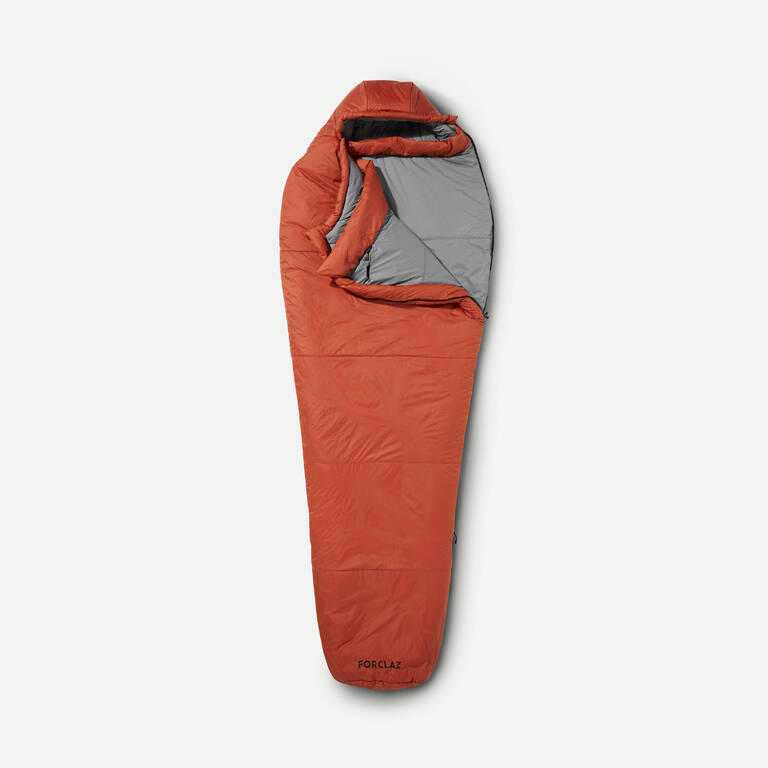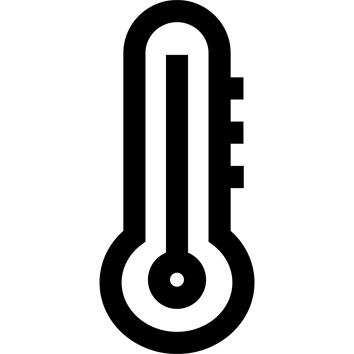

Stores
Contact us
You only need one connection
to enjoy all your favorite services
Rather easy, would you say?

















Cannot ship to ()


This product is currently unavailable for your region
Please select a size...





My experience with this sleeping bag on a February winter trek to Annapurna Base Camp was positive overall. It kept me comfortably warm despite the harsh conditions, although it did take up a significant amount of space and added some weight to my pack.
J'ai acheté ce sac de couchage Forclaz MT500 pour avoir une alternative à mon duvet, un modèle plus robuste et moins fragile. Après l'avoir testé à 2000 mètres d'altitude par une température avoisinant les -6°C, je suis agréablement surpris : je n'ai eu aucun froid du tout ! Le confort était vraiment au rendez-vous, ce qui m'a permis de passer une nuit chaude et agréable.
Il est vrai que le sac est un peu lourd et légèrement encombrant, mais cela ne m'a pas dérangé. Personnellement, ça ne pose aucun problème, car l'essentiel est que j'ai dormi confortablement et au chaud. C'est un critère primordial, et ce sac remplit parfaitement cette mission. D'ailleurs, il n'est pas plus gros que mon duvet Frand Froid, ce qui est un vrai plus en termes de praticité.
Contrairement à certains avis que j'avais vus sur le site, je n'ai eu aucun souci pour remettre le sac dans son sac de rangement. Il n'y a pas besoin de le plier à la perfection, un simple "bourrage" dans le sac fait l'affaire, et il est rangé en quelques secondes sans prise de tête. Pas besoin de se casser la tête à le plier, ça reste un sac de couchage après tout !
En résumé, je suis vraiment satisfait de cet achat, et je le recommande vivement à ceux qui recherchent un sac de couchage robuste et performant pour les conditions fraîches à froides.
Un très bon produit bien placé niveau prix et franchement très chaud.
Utilisé sur une sortie de 3 jours où il y a eu des gelées matinales, aucun souci.
Il prend un très beau volume et protège parfaitement.
Revers de la médaille, il faut le plier et le compresser minutieusement pour le remettre dans son sac ! pas évident les premières fois, faut pas être pressé de repartir ;-).
Fiyat performans
konfor aralığında değerlerde güzel denilebilir ama bu durumda biraz kişiden kişiye değişiyor bana göre bu tulumun konfor değeri 0 + 5 Derece için İdeal bu eksi derecede kullandığım zaman lokal olarak soğuk ısırması kaçınılmaz oluyor gibi ideal olan bu tulumun 0 dereceye kadar sizin işinizi görecek olduğunu bilmeniz zaten sentetik tulumlarda daha düşük konfor derecesi bulamıyorsunuz eksi derecelerde kamp yapacaksanız bence kaz tüyü tulumlara bakmak gerekir kış döneminde herhangi bir yüksek rakımda minimum -15 göreceksiniz sobalı çadırda kalsanız bile soba geçince dış ortam ile aynı değere geliyor çadırın içi yani tulum hayati bir öneme sahip seçiminizi bilinçli yapınız istanbul içinde bu konfor değeri işinizi görür
-15 konfor değeri olan sentetik tulum olsa enazından kış için daha garantili olurdu her koşul için keşke seçenek olsa ama yok
Ürün gayet hafif,rengi çok güzel,sıcak tutuyor
Für diesen Preis hatt ich nicht viel erwartet und war erstaunt, das der Schlafsack beim ersten Test bei -2° und dünner Schlafbekleidung Komfot-Temperatur gehalten hat. Weiter runter geht es dann aber ohne "Nachhilfe" nicht mehr.
In Kombination mit einem Sommerschlafsack (Abisko Two Sewasion) hatte ich bei -6° fast noch einen Wärmestau.
Der Schlafsack ist sehr weit geschitten, daurch sehr bequem und es passt locker ein weiterer Schlafsack hinein ohne das er spannt. Daher der perfekte Kombinationsschlafsack, wenn mal richt Kalt wird.
Ich selber würde vermuten, das man in Kombination bie -8°C oder tiefer warm schlafen kann. (leider sind diese Temperaturen hier sehr selten).
Es gibt aber auch einen Punkt zur Verbesserung: der Klemmer für die Kaputzeneinstellung ist sehr ungünstig geformt und man weis nie wo man drücken soll. Den sollte man tauschen!
chaud et confortable mais très imposant, volumineux et lourd
Ürünü Ocak sonu Şubat başında yaylada kamp yaparken kullandım altımda yalıtımlı şişme mat vardı resmen terledim fazla durunca, ara ara havalandirdim ayaklarımdan basima kadar hiç usumedim gece yarısı-7 dereceyi geçmişti kılıfı biraz daha sağlam ve sıkıştırılabilir olsa daha güzel olurmuş onun dışında harika ürün
Musiałam zwrócić bo był za mały i dużo miejsca zajmuje w plecaku, ale poza tym dobra jakość! Jedyny uciążliwy minus to zapakowanie go z powrotem do pokrowca.





My experience with this sleeping bag on a February winter trek to Annapurna Base Camp was positive overall. It kept me comfortably warm despite the harsh conditions, although it did take up a significant amount of space and added some weight to my pack.
J'ai acheté ce sac de couchage Forclaz MT500 pour avoir une alternative à mon duvet, un modèle plus robuste et moins fragile. Après l'avoir testé à 2000 mètres d'altitude par une température avoisinant les -6°C, je suis agréablement surpris : je n'ai eu aucun froid du tout ! Le confort était vraiment au rendez-vous, ce qui m'a permis de passer une nuit chaude et agréable.
Il est vrai que le sac est un peu lourd et légèrement encombrant, mais cela ne m'a pas dérangé. Personnellement, ça ne pose aucun problème, car l'essentiel est que j'ai dormi confortablement et au chaud. C'est un critère primordial, et ce sac remplit parfaitement cette mission. D'ailleurs, il n'est pas plus gros que mon duvet Frand Froid, ce qui est un vrai plus en termes de praticité.
Contrairement à certains avis que j'avais vus sur le site, je n'ai eu aucun souci pour remettre le sac dans son sac de rangement. Il n'y a pas besoin de le plier à la perfection, un simple "bourrage" dans le sac fait l'affaire, et il est rangé en quelques secondes sans prise de tête. Pas besoin de se casser la tête à le plier, ça reste un sac de couchage après tout !
En résumé, je suis vraiment satisfait de cet achat, et je le recommande vivement à ceux qui recherchent un sac de couchage robuste et performant pour les conditions fraîches à froides.
Un très bon produit bien placé niveau prix et franchement très chaud.
Utilisé sur une sortie de 3 jours où il y a eu des gelées matinales, aucun souci.
Il prend un très beau volume et protège parfaitement.
Revers de la médaille, il faut le plier et le compresser minutieusement pour le remettre dans son sac ! pas évident les premières fois, faut pas être pressé de repartir ;-).
Fiyat performans
konfor aralığında değerlerde güzel denilebilir ama bu durumda biraz kişiden kişiye değişiyor bana göre bu tulumun konfor değeri 0 + 5 Derece için İdeal bu eksi derecede kullandığım zaman lokal olarak soğuk ısırması kaçınılmaz oluyor gibi ideal olan bu tulumun 0 dereceye kadar sizin işinizi görecek olduğunu bilmeniz zaten sentetik tulumlarda daha düşük konfor derecesi bulamıyorsunuz eksi derecelerde kamp yapacaksanız bence kaz tüyü tulumlara bakmak gerekir kış döneminde herhangi bir yüksek rakımda minimum -15 göreceksiniz sobalı çadırda kalsanız bile soba geçince dış ortam ile aynı değere geliyor çadırın içi yani tulum hayati bir öneme sahip seçiminizi bilinçli yapınız istanbul içinde bu konfor değeri işinizi görür
-15 konfor değeri olan sentetik tulum olsa enazından kış için daha garantili olurdu her koşul için keşke seçenek olsa ama yok
Ürün gayet hafif,rengi çok güzel,sıcak tutuyor
Für diesen Preis hatt ich nicht viel erwartet und war erstaunt, das der Schlafsack beim ersten Test bei -2° und dünner Schlafbekleidung Komfot-Temperatur gehalten hat. Weiter runter geht es dann aber ohne "Nachhilfe" nicht mehr.
In Kombination mit einem Sommerschlafsack (Abisko Two Sewasion) hatte ich bei -6° fast noch einen Wärmestau.
Der Schlafsack ist sehr weit geschitten, daurch sehr bequem und es passt locker ein weiterer Schlafsack hinein ohne das er spannt. Daher der perfekte Kombinationsschlafsack, wenn mal richt Kalt wird.
Ich selber würde vermuten, das man in Kombination bie -8°C oder tiefer warm schlafen kann. (leider sind diese Temperaturen hier sehr selten).
Es gibt aber auch einen Punkt zur Verbesserung: der Klemmer für die Kaputzeneinstellung ist sehr ungünstig geformt und man weis nie wo man drücken soll. Den sollte man tauschen!
chaud et confortable mais très imposant, volumineux et lourd
Ürünü Ocak sonu Şubat başında yaylada kamp yaparken kullandım altımda yalıtımlı şişme mat vardı resmen terledim fazla durunca, ara ara havalandirdim ayaklarımdan basima kadar hiç usumedim gece yarısı-7 dereceyi geçmişti kılıfı biraz daha sağlam ve sıkıştırılabilir olsa daha güzel olurmuş onun dışında harika ürün
Musiałam zwrócić bo był za mały i dużo miejsca zajmuje w plecaku, ale poza tym dobra jakość! Jedyny uciążliwy minus to zapakowanie go z powrotem do pokrowca.

